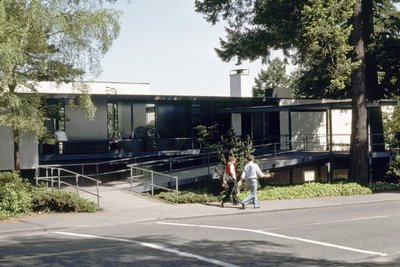August 20, 2009
UW Club nominated for National Register of Historic Places
It’s part of the drill in luring fine scholars to be faculty members at the UW: Take ’em to lunch at the UW Faculty Club, show ’em around the building and encourage ogling out wall-to-wall windows at Lake Washington and the Cascade Mountains.
As a prominent example of mid-20th-century architecture, the club has been nominated for the National Register of Historic Places. The Governor’s Advisory Council on Historic Preservation will consider the nomination Oct. 23.
Kathryn Rogers Merlino, a professor in the College of Built Environments, is leading the effort.
“The UW Club is one of the finest examples, if not the finest example of International Style in the Pacific Northwest,” Merlino said.
A series of rectangles, one of which seemingly floats eastward toward the lake, the club is made of smooth, stripped-down steel, glass, stucco and local woods typical of mid-20th-century design.
Designed by two well-known Pacific Northwest modernist architects, Paul Hayden Kirk and Victor Steinbrueck, the club was built in 1960 on the east side of Stevens Way, across from the Husky Union Building.
As part of the design, Kirk and Steinbrueck incorporated all regionally grown softwoods: hemlock, tamarack, Alaska and Western red cedar, Ponderosa and lodge pole pine. Most walls are paneled, but large panes of glass seem to make walls fall away in favor of the view, particularly in the dining room that runs the east side of the building.
Within a year of construction, the club had won several local and regional awards, including the 1960 Honor Award for Washington Architecture, the highest regional award given by the American Institute of Architecture.
The current club is actually the second one. The first was Hoo Hoo House, designed for the Hoo Hoo lumberman association for the Alaska Yukon Pacific Exposition in 1909. According to the National Register nomination, the house was razed in 1959 as insufficient for University use. Steinbrueck, however, reused parts: the club bar, for example, is paneled with blackened softwood from the house.
Listing on the National Register is honorific, so owners can make changes without special approval, but according to Merlino, the designation makes most people think twice before doing that.
About 85,000 properties around the country are listed on the National Register. About 2,430 properties, including Mount Vernon and Pearl Harbor, are also listed as National Historic Landmarks.




